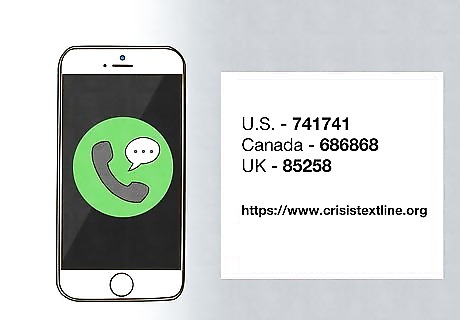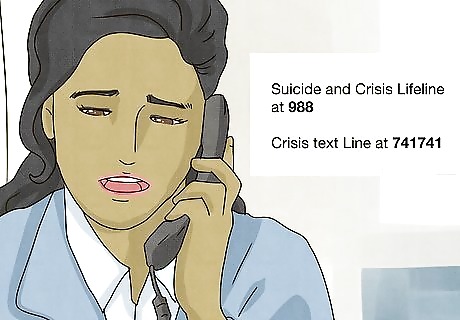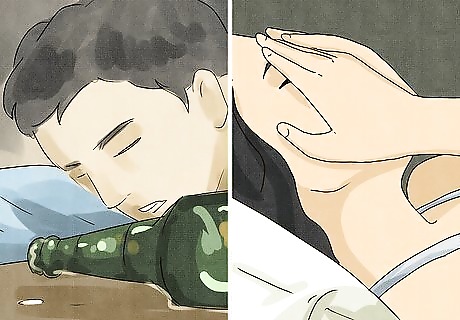
views
X
Trustworthy Source
National Suicide Prevention Lifeline
Suicide prevention network operating a toll-free 24/7 hotline for anyone experiencing suicidal thoughts or emotional distress
Go to source
Whether your friend told you they were thinking of suicide or you just sense a possibility, you should act; doing so can save a life. Call or text the US Suicide and Crisis Lifeline at 988 or call the UK Suicide hotline at 116 123 [2]
X
Trustworthy Source
National Health Service (UK)
Public healthcare system of the UK
Go to source
, or text 741741 to chat with someone at the Crisis Text Line.[3]
X
Trustworthy Source
National Suicide Prevention Lifeline
Suicide prevention network operating a toll-free 24/7 hotline for anyone experiencing suicidal thoughts or emotional distress
Go to source
Talking to a Suicidal Person

Understand the principle behind suicide prevention. Suicide prevention is most effective when suicide risk factors are reduced or de-emphasise and protective factors are strengthened. To intervene in a suicide attempt, work on offering or strengthening those protective factors, as you may have less control over the risk factors. Risk factors include a history of suicide attempts and mental disorders; for a more comprehensive list, see Method 3: "Understanding Suicide Trends." Protective factors include clinical treatment, family and community support, support from healthcare professionals, and development of problem solving and conflict resolution skills.

Show that you care. The best protective factors to combat feelings of isolation (a strong risk factor) are emotional support from and connectedness to friends, family, and community. A suicidal person needs to have a sense of belonging to choose life, so you should show the person that they are an important part of your life. Think of ways that you can provide them with support or remove stress from their life.

Engage adolescents’ or young adults’ enthusiasm about their interests. If the person you are concerned about is young, do research about their special interest(s) so that you can have a conversation with them about them. The main goal is to show that you care enough about the person to take their interests and recommendations seriously. Ask open questions that lead them to share their enthusiasm or interests openly with you. You can ask questions like: “How did you learn so much about (fill in the blank)?” “Can you tell me more about that?” “I love your personal style; how do you decide what to wear? Do you have any fashion advice for me?” “I watched the movie you recommended and really enjoyed it. Do you have any other recommendations?” “What is your favorite movie? Why is it your favorite?” “What hobby or activity could you spend your whole life doing?”

Help elders feel useful. If you know an elder who may be contemplating suicide due to feelings of helplessness or being a burden, try to make them feel useful or relieve some of their burden. Ask the person to teach you something, like how to cook a favorite recipe or how to knit or play a favorite card game. If the person has health or transportation issues, offer to drive them somewhere or bring them a home cooked meal. Express interest in the person’s life or ask for advice dealing with a problem. You could ask questions like: “What was your life like when you were a teenager?” “What is your favorite memory?” “What is the biggest change you’ve seen in the world during your life?” “How would you support someone who is being bullied?” “How did you deal with being overwhelmed as a parent?”

Do not be afraid to talk about suicide. Some cultures or families treat suicide as a taboo and avoid talking about it.. You may also be afraid that if you talk to someone about suicide, you will prompt them to act on their suicidal thoughts. These factors or others may lead you to hesitate to speak openly about suicide. However, you should fight this instinct because the opposite is actually true; speaking openly about suicide often prompts someone in crisis to think about and reconsider their choices. For example, during an anti-suicide project on a Native American Indian reservation with a high suicide rate, several eighth-graders admitted to actively planning suicides until they participated in open discussions about suicide. These open discussions violated cultural taboos, but they resulted in each of the participants choosing life and signing a pledge to avoid suicide.

Prepare to talk to someone about suicide. After educating yourself about suicide and reemphasizing your relationship with the suicidal person, prepare to talk to them. Set up a comfortable environment in a non-threatening place to have a conversation about your concerns. Minimize possible distractions by turning off electronics, silencing phones, and arranging for roommates, children, or other people to be occupied safely somewhere else.

Be open. Offer non-judgmental, non-accusatory support and listen with an open mind that invites closeness. You do not want your conversation to build a barrier between you; avoid this by showing that you are open and you care. It is easy to become frustrated when speaking to someone in crisis who isn’t thinking clearly, so remind yourself to remain calm and supportive. The best way to be open is to not have any prepared responses for your loved one. Ask a few open questions like "how are you feeling?" or "what is upsetting you" and let them speak. Do not try to argue with them or convince them that things aren't really that bad.

Speak clearly and directly. There is no point in sugar-coating or tiptoeing around the subject of suicide. Be open and clear about what is on your mind. Consider using a 3-prong conversation starter, which reinforces the relationship, explains what you have noticed, and shares that you care. Then ask about whether they have been having suicidal thoughts. For example, “Amy, you and I have been friends for 3 years. Lately, you’ve seemed depressed, and you’re drinking more. I’m very worried about you, and I’m worried that you may have been thinking about suicide.” For example, “Son, when you were born, I promised I’d always be here for you. You’re not eating or sleeping like you normally do, and I’ve heard you crying several times. I would do anything to not lose you. Are you thinking about killing yourself?” For example, “You’ve always been such a great role model. But you recently made a comment about hurting yourself. You are very special to me. If you are suicidal, please talk to me about it.”

Allow for silence. After you have started the conversation, the person may respond with they had done something that would make you think that they were suicidal. They may want some time to gather their thoughts before they are ready to respond to you.

Be persistent. If the person brushes off your concern with “no, I’m fine” or doesn’t respond to you, share your concerns again. Provide them with another opportunity for response. Remain calm and do not badger them, but be firm in your conviction that you want them to talk to you about what is bothering them.

Let the person talk. Listen to what them say, and accept the feelings that they are expressing, even if they are painful for you to hear. Don’t try to argue with them or lecture them about what they should do. Offer options to get through the crisis and hope if possible.

Validate the person’s feelings. When talking to someone about their feelings, it is important that you validate the feelings rather than try to “talk sense into them” or convince them that their feelings are irrational. For example, if someone tells you that they are contemplating suicide because their beloved pet just died, it is not helpful to tell them that they are overreacting. If they say that they have just lost their one true love, don’t tell them they're too young to understand love or that there are other fish in the sea.

Do not try to “call the person’s bluff.” This may seem obvious, but you should not dare or encourage a person to take their life. You may see it as an approach that will enable the person to see that they are being silly, or even give them the opportunity to realize that they really want to live. However, your “push” could actually push them into acting, and you would likely feel responsible for their death.

Thank the person for being open with you. If the person admits that they have had thoughts of suicide, express your thanks for being entrusted with the information. You may want to also ask if they have shared their thoughts with anyone else, and if anyone else had offered them any help for coping with their feelings.

Suggest asking for outside help. Encourage the person to call or text the Suicide and Crisis Lifeline at 988 to talk to a trained professional. The professional on the hotline can provide tips for developing coping skills to get through a suicidal crisis. Don’t be surprised if they reject the idea of calling the lifeline, but write the number down for them or program it into their phone so that they can call it if they have a change of heart. If you think they would be more comfortable texting someone, encourage them to send a message to the Crisis Text Line. If you live in the US, the number is 741741, 686868 if you live in Canada, and 85258 if you live in the UK. For more information, visit https://www.crisistextline.org.

Ask if there is a suicide plan. You should encourage your friend or loved one to share the details of their suicidal thoughts with you. This will likely be the most difficult part of the conversation for you, as it will make the threat of suicide seem more real. However, knowing the specific plan may enable you to minimize the risk of the suicide death. If the person has gone far enough in their suicidal thoughts to make a plan, it is very important that you get them help.

Make a deal with the suicidal person. Before ending your conversation, exchange promises. You should promise that you are available to talk to them at any time, night or day. In exchange, ask them to promise that they will call you before taking any suicidal action. That promise may be enough to make them stop and get help before taking an action that is irreversible.
Taking Action against Suicide

Minimize opportunities for self-harm in an emergent crisis. Do not leave the person alone if you believe they are in crisis. Seek immediate help by calling 9-1-1, a crisis intervention specialist, or a trusted friend.

Remove any means of self-harm. If someone is in a suicidal crisis, practice means restriction, which involves reducing their ability to harm themselves. It is particularly important to remove any items that were specifically part of a visualized suicide plan. Most men who take their lives choose guns to harm themselves, while women are more likely to poison themselves with drugs or toxic chemicals. Remove the person’s access to firearms, medications, toxic chemicals, belts, ropes, very sharp knives or scissors, cutting tools like saws, and/or any other items that may facilitate a suicide. Your goal in removing the means of suicide is to slow down the suicide process so that the person has time to calm themselves down and choose to live.

Call for help. The person in crisis will likely ask you to keep their feelings of suicide a secret. However, you should not feel obligated to keep this request; this is a life-threatening event, so calling a crisis management specialist to help is not a violation of the person’s trust. You may want to call on one or more of the following resources for help: the Suicide and Crisis Lifeline at 988 the Crisis text Line at 741741 if you'd prefer to send a message a school counselor or spiritual leader such as a priest, pastor, or rabbi the person in crisis’s doctor 9-1-1 (if you feel the person is in immediate danger)
Understanding Suicide Trends

Understand the severity of suicide. Suicide is the culminating act in the process of overcoming the human instinct towards self-preservation. Suicide is a worldwide problem; in the year 2012 alone, around 804,000 people ended their own lives. In the US, suicide is a leading cause of death, with a suicide occurring around every 5 minutes. In the year 2012, there were over 43,300 suicide deaths in the US.

Recognize the progression of suicide. Though the trigger for the suicidal act may be sudden and the act impulsive, suicide happens in progressive stages that are often recognized by others in hindsight. The stages of suicide include: Stressful events which trigger sadness or depression Suicidal thoughts in which the individual questions whether to continue living Making plans to attempt suicide in a specific way Suicidal preparation, which can include gathering the means to take their own life and giving away possessions to loved ones Suicide attempt in which an individual tries to end their own life

Watch for depression and anxiety around major life changes. People of all age experience life changes that can bring out feelings of anxiety and depression. Most people are able to recognize that it is normal to have problems and that situations are temporary. However, some people become so mired in their depression and anxiety that they cannot see beyond the immediate moment. They have no hope and see no options to escape the pain that they are feeling. People having suicidal thoughts seek to end the pain of a (temporary) situation with a (permanent, irreversible) solution. Some people even believe the fact that they feel suicidal means that they are crazy, and if they’re crazy, they might as well take their own life. This is untrue on two levels. First, people without mental illness can contemplate suicide. Second, those who do suffer from mental illness are still worthwhile individuals with a lot to offer.

Take any suicide threat seriously. You may have heard that people who are serious about dying by suicide don’t talk about it. This is untrue! Someone speaking about suicide openly may be asking for help the only way they know how, and if no one offers help, they may give in to the darkness that is overwhelming them. In a recent study, 8.3 million American adults admitted contemplating suicide the previous year. 2.2 million made plans for a suicide attempt, and 1 million attempted suicide. It is believed that for every complete adult suicide, there are 20 to 25 attempts. In the 15-24 year-old age group, there are as many as 200 attempts for each complete suicide. More than 15% of American high school students surveyed admitted to contemplating suicide. 12% of those made a specific plan, and 8% attempted suicide. These statistics suggest that if you suspect that someone is considering suicide, you’re likely to be correct; it’s best to assume you’re right and ask for help.

Don’t assume your friend/loved one is not the “kind of person” who would die by suicide. It might be easier to prevent suicide if there were a specific profile for the kind of person who takes their own life, but there is not. Suicide can affect people from every country, ethnicity, gender, age, religion, and economic level. Some people are surprised to find that even children as young as 6 and elderly people who feel that they have become a burden to their families sometimes take their own lives. Do not assume that only people who are mentally ill attempt suicide. The suicide rate is higher in those with mental illness, but people without mental illness also choose to die by suicide. Additionally, people who do have a diagnosed mental illness may not share that information openly, so you may be unaware of someone’s mental illness.

Be aware of trends in suicide statistics. Though suicidal thoughts can happen to anyone, there are certain patterns that can identify groups that are higher risk. (Cisgender) men are 4 times more likely to die by suicide, but (cisgender) women are more likely to have suicidal thoughts, voice those suicidal thoughts to others, and have non-fatal suicide attempts. Native Americans have higher suicide rates than other ethnic groups. Adults under 30 tend to think about a plan for suicide more than adults over 30. Among teenage girls, Hispanic girls have the highest rate of suicide attempts.

Recognize risk factors for suicide. It is important to remember, as specified above, that suicidal individuals are unique and don’t fit into a specific mold. However, knowing the following risk factors may help you determine whether your friend is at risk. Individuals are at higher risk for suicide if they: have a history of suicide attempt(s) suffer from mental illness, often depression abuse alcohol or drugs, including prescription painkillers have health problems or chronic pain have employment or financial problems feel as though they are alone or isolated and lack social support have relationship problems have family members who have died by suicide are victims of discrimination, violence, or abuse experience feelings of hopelessness

Watch for the three most serious risk factors. Dr. Thomas Joiner believes that three factors that best predict suicide are feeling isolated, feeling like a burden to others, and having learned to hurt oneself. He calls suicide attempts “rehearsals” for actual suicide rather than cries for help. He explains that those most likely to die by suicide: are desensitized to physical pain do not fear death

Recognize common warning signs of suicide. Warning signs differ from risk factors (see above) in that they indicate an imminent risk for a suicide attempt. Some people take their own life with no warnings, but most people who attempt suicide say or do things that can serve as red flags to warn others that something is wrong.If you see some or all of the following warning signs, intervene immediately to prevent a tragic death. Some warning signs include: changes in sleeping or eating habits increased alcohol, drug, or painkiller usage inability to work, think clearly, or make decisions expression of feelings of extreme unhappiness or depression expression of feelings of isolation or the impression that no one notices or cares about them sharing feelings of worthlessness, hopelessness, or lack of control complaints of pain and an inability to visualize a pain-free future threats of self-harm giving away valuable or cherished possessions a sudden period of happiness or surge of energy after a long stretch of depression
















Comments
0 comment